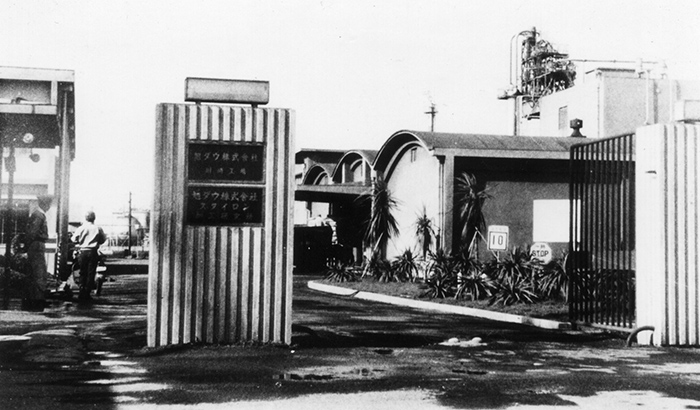When we were building the Cashmilon plant, I decided we also needed to produce our own acrylonitrile monomer, the main raw material. I thought it was important for us to have integrated production from the raw material to strengthen the Cashmilon business.
We were purchasing acrylonitrile monomer from domestic petrochemical manufacturers like Mitsubishi Kasei Kogyo and from abroad, but we couldn’t be assured of supply and the cost was high. I got the President’s approval since I was still a Managing Director, and instructed the technical team not only to improve Cashmilon product quality but also to quickly establish our own technology to produce the monomer. Around the fall of 1959, we developed our own breakthrough technology to produce acrylonitrile monomer directly from propylene and ammonia.
In the global chemical industry, a two-stage process to produce acrylonitrile monomer through an intermediate had just been commercialized. A one-stage process to make the monomer directly was considered impossible. But Asahi Kasei’s technical team achieved it, and if we could commercialize the process we could cut costs significantly.
Then we heard that Sohio in the United States had developed the same technology. But the information was vague and we weren’t sure if it was truly a one-stage process or if an intermediate might still be needed. We wanted to find out as soon as possible.
We were still doubtful when an engineer from Sohio came to Japan and visited Asahi Kasei. We confirmed that they had indeed developed the one-stage process, and found out that they had just filed a patent application in Belgium. We had also filed a patent application, just two days after Sohio. But Sohio still hadn’t commercialized the process.
Asahi Kasei had to choose between developing original technology to avoid infringing the patent, adopting a process completely different than Sohio’s, or just giving up on producing our own monomer.
Most of the executives felt that we shouldn’t rush into monomer production. This was 1959, when the Cashmilon plant was going through a series of difficulties, so it was natural for them to feel this way.
But I was adamant that we should aim for integrated production. I felt that expanding into the monomer was essential to strengthen the Cashmilon business, and would lead to additional new business opportunities.
I visited Sohio in February 1960, determined to license the process on my own accord. I was confident because I had done enough research in advance, but I was also prepared to take responsibility if I failed.
Right after I returned to Japan, we applied to the government for approval to import the technology, and as soon as the approval was granted, we started building a plant in Kawasaki with a daily output of 15 tons. But as soon as construction began, imports from the United States surged, causing the market price to collapse from 260 yen per kilogram to 220 yen.
A plant with a daily output of only 15 tons is unprofitable at this price. Some executives who opposed my hardline stance called for the construction to be halted.
Mr. Kuroda was in charge of this project, and he insisted that “It is very meaningful for Asahi Kasei to expand to acrylonitrile monomer, just like Asahi-Dow did with Styron.” Encouraged by his enthusiasm, I pressed ahead with commercialization.
I went around persuading people in the company, and construction of the plant was completed in 1962. Fortunately, the monomer price had recovered by that time. Though we feared there might be problems, it started up smoothly. It was the first one-stage acrylonitrile plant in the world.
Unlike the Cashmilon plant, this plant was on track from the beginning. We made successive expansions, and by 1964 raised it to a daily output of 100 tons. I had been involved in starting several new businesses, but the only ones that were profitable from the beginning were Asahi-Dow’s Styron and this acrylonitrile monomer.
This not only improved Cashmilon’s cost competitiveness , but moreover it reinforced our foundations in the field of petrochemicals that we entered with the creation of Asahi-Dow.
 AN Plant in Kawasaki, 1962
AN Plant in Kawasaki, 1962
 The main gate of Asahi Dow Kawasaki plant, 1957
The main gate of Asahi Dow Kawasaki plant, 1957

